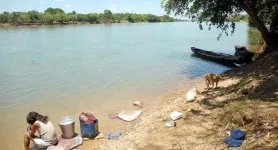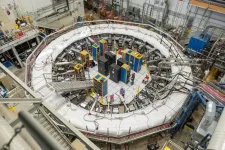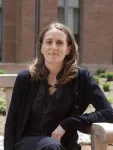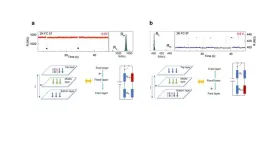(Press-News.org) Brazilian researchers combined environmental physical, social and economic indicators to create an index that measures a region’s vulnerability and used it to analyze the basins of the Parnaíba River and São Francisco River in the Northeast of Brazil. The index is named SEVI (for Socio-Environmental Vulnerability).
The Parnaíba and São Francisco basins are considered crucial to agricultural expansion and biodiversity conservation. They contain more than 780 municipalities and part of the semi-arid Caatinga and savanna-like Cerrado biomes, which are threatened by deforestation as well as adverse effects of climate change.
The study shows that the main obstacles to improving the socio-environmental vulnerability of the Parnaíba basin, the second largest river basin in the Northeast, are deficits in infrastructure, income, and conditions for human development, all of which impair adaptive capacity, defined by the researchers as “the ability of a system to evolve in order to accommodate environmental hazards or anthropogenic impacts”. In the São Francisco basin, the most significant causes of vulnerability are population density, soil degradation/desertification, and climate factors, especially temperature and precipitation.
These findings are reported in an article on the study published in the journal Sustainability. The authors are affiliated with the National Space Research Institute (INPE) and the National Disaster Surveillance and Early Warning Center (CEMADEN). The study was supported by FAPESP and by Forests 2020, part of the United Kingdom Space Agency’s International Partnerships Program (IPP) involving experts on forest monitoring in Indonesia, Brazil, Colombia, Mexico, Belize, Ghana and Kenya, as well as the UK.
“The study showed that sustainable development projects should take specific characteristics of each region into consideration and brought to light the deficiencies of some public policies. We analyzed a problem that affects agricultural areas in several countries, especially in the developing world,” biologist Rita Marcia da Silva Pinto Vieira, first author of the article, told Agência FAPESP. She was at INPE when the study was conducted.
Including socio-economic indicators allowed the researchers to strengthen the argument that sustainability is not linked only to climate, environmental factors and soil degradation but also to human activity and biodiversity.
“Vulnerability indicators typically focus on one factor in isolation. By integrating environmental and socio-economic data, we showed that vulnerability has as much to do with exposure to environmental, social and political stress as it does with the system’s capacity to adapt. The index highlights areas where vulnerability is particularly acute,” said Lincoln Muniz Alves, a climatologist at INPE and penultimate author of the article.
The last author is Jean Pierre Ometto, a senior researcher in the Impact, Adaptation and Vulnerability Division of INPE’s Department of Earth Sciences (DIIAV-CGCT).
Methodology
The SEVI index resulted from a combination of indicators relating to adaptation (human development, infrastructure and income), sensitivity (days without rain, land use and cover, temperature, and soil type), and exposure (population density and soil degradation or desertification).
The methodology was based on the environmentally sensitive areas (ESA) approach developed by MEDALUS (Mediterranean Desertification and Land Use), a project conducted in eight European Union countries in the late 1980s and early 1990s. The indicators and overall index were weighted from very low to very high.
The area of the regions analyzed totaled about 962,000 square kilometers (km²), with a population of some 20 million, mostly urban. Sixteen million people live in the São Francisco basin. The river runs through six states from Minas Gerais to the Alagoas-Sergipe border. Four million live in the Parnaíba basin.
According to the SEVI index, vulnerability levels were “very high” and “high” in 53% of the São Francisco basin, pointing to 337,569 km² with socio-environmental fragilities, partly coinciding with desertification hotspots officially recognized by the Environment Ministry. In the Parnaíba basin, the proportion was 37% (121,990 km²).
Adaptive capacity was “very low” and “low” in 57% of the area analyzed (549,830 km²). Exposure was “very high” and “high” in 62.8% and 30.7% of the São Francisco and Parnaíba basins respectively. Sensitivity was also high in a significant proportion of both (341,726 km² and 123,666 km²). These results mainly reflected population density, soil degradation, desertification, and the number of days without rain, which directly influences the risk of wildfires during the dry season.
The authors of the article expect these problems to become steadily worse as a consequence of climate change. Previous research using global models projected a drop of 46% and 26% in streamflow in the São Francisco and Parnaíba rivers respectively in the decades ahead, and socio-environmental vulnerability is set to increase significantly, especially in areas where the population is poor, as extreme weather becomes more frequent.
Furthermore, deforestation has hit the region hard in recent years. In the Cerrado, it affected 10,689 km² in 2022, more than in any year since 2015 (11,129 km²), and in the Caatinga, it increased 25% compared with 2021, according to INPE’s monitoring program (PRODES).
This year, the number of deforestation alerts for the Cerrado jumped 35% in the first five months compared with the corresponding period of 2022, according to INPE’s early warning system (DETER).
Protected areas
The researchers also analyzed conservation units located in both basins, concluding that units in the Parnaíba basin were less vulnerable. In the São Francisco basin, 32.4% of the area (12,477 km²) was highly vulnerable within a 5 km buffer zone, indicating human pressure from deforestation and burning in fully protected areas.
On the upside, Lapa Grande State Park in Minas Gerais was the most well-preserved conservation unit in the region, with low vulnerability in 84.6% of its area.
“The study pinpointed the areas with high vulnerability and emphasized the importance of conservation units. In our recommendations, we stress that the sustainable practices used in these units can also be implemented in adjacent areas,” Alves said.
For the authors, it is critically important to extend conservation units, introduce sustainable land management practices in adjacent buffer zones, and develop strategies for the protection of ecosystem services and local vegetation.
These management practices and their modernization should be shared with farmers in the region, according to the article. Many smallholders located in the areas with high socio-environmental vulnerability lack funds, and their traditional land-use practices deplete natural resources and aggravated poverty.
Contributions
According to the authors, the information on socio-environmental vulnerability with regional characteristics provided by the SEVI index contributes to support for programs such as the National Climate Change Adaptation Plan (PNA), as well as public policies aimed at rehabilitating degraded areas.
“We used specific variables for the Caatinga and Cerrado, but the methodological framework we developed for SEVI can certainly be applied elsewhere, using the peculiarities of each region and biome,” Vieira said.
About São Paulo Research Foundation (FAPESP)
The São Paulo Research Foundation (FAPESP) is a public institution with the mission of supporting scientific research in all fields of knowledge by awarding scholarships, fellowships and grants to investigators linked with higher education and research institutions in the State of São Paulo, Brazil. FAPESP is aware that the very best research can only be done by working with the best researchers internationally. Therefore, it has established partnerships with funding agencies, higher education, private companies, and research organizations in other countries known for the quality of their research and has been encouraging scientists funded by its grants to further develop their international collaboration. You can learn more about FAPESP at www.fapesp.br/en and visit FAPESP news agency at www.agencia.fapesp.br/en to keep updated with the latest scientific breakthroughs FAPESP helps achieve through its many programs, awards and research centers. You may also subscribe to FAPESP news agency at http://agencia.fapesp.br/subscribe.
END
Novel socio-environmental vulnerability index pinpoints sustainability issues in Brazilian river basins
The innovative approach highlights vulnerability to deforestation, fire and drought, as well as poverty. The results can help formulate public policies for sustainable development
2023-08-10
ELSE PRESS RELEASES FROM THIS DATE:
Mayo Clinic ‘mini-brain’ study reveals possible key link to autism spectrum disorder
2023-08-10
ROCHESTER, Minn. — Using human "mini-brain" models known as organoids, Mayo Clinic and Yale University scientists have discovered that the roots of autism spectrum disorder may be associated with an imbalance of specific neurons that play a critical role in how the brain communicates and functions. The specific cells are known as excitatory cortical neurons.
The new study is published in Nature Neuroscience.
Findings
The team found an abnormal imbalance of excitatory ...
Muon g-2 doubles down with latest measurement, explores uncharted territory in search of new physics
2023-08-10
Batavia, Ill., Aug. 10, 2023 – Physicists now have a brand-new measurement of a property of the muon called the anomalous magnetic moment that improves the precision of their previous result by a factor of 2.
An international collaboration of scientists working on the Muon g-2 experiment at the U.S. Department of Energy’s Fermi National Accelerator Laboratory announced the much-anticipated updated measurement on Aug. 10. This new value bolsters the first result they announced in April 2021 and sets up a showdown between theory and experiment over 20 years in the making.
“We’re really probing new territory. We’re determining ...
Making molecules dance to our tune reveals what drives their first movements
2023-08-10
Bringing ultrafast physics to structural biology has revealed the dance of molecular ‘coherence’ in unprecedented clarity.
How molecules change when they react to stimuli such as light is fundamental in biology, for example during photosynthesis. Scientists have been working to unravel the workings of these changes in several fields, and by combining two of these, researchers have paved the way for a new era in understanding the reactions of protein molecules fundamental for life.
The large international research team, led by Professor ...
Gut microbiome can increase risk, severity of HIV, EBV disease
2023-08-10
CHAPEL HILL, N.C. – Over the past decade, the gut microbiome has gained significant interest by scientists and non-scientists alike. Recent research has shown that the bacteria and other microbes in our gut play a supporting role in immunity, metabolism, digestion, and the fight against "bad bacteria" that try to invade our bodies.
However, new research published in Nature Biotechnology by Angela Wahl, PhD, Balfour Sartor, MD, J. Victor Garcia, PhD, and UNC School of Medicine colleagues others has revealed that the microbiome may not as always be protective against human pathogens.
Using a first-of-its-kind ...
YALE EMBARGOED NEWS: Yale scientists reveal two paths to autism in the developing brain
2023-08-10
New Haven, Conn. — Two distinct neurodevelopmental abnormalities that arise just weeks after the start of brain development have been associated with the emergence of autism spectrum disorder, according to a new Yale-led study in which researchers developed brain organoids from the stem cells of boys diagnosed with the disorder.
And, researchers say, the specific abnormalities seem to be dictated by the size of the child’s brain, a finding that could help doctors and researchers to diagnosis and treat autism in the future.
The findings were ...
Before reaching the skies, the Himalayas had a leg up, new study shows
2023-08-10
Mountain ranges play a key role in global climate, altering weather and shaping the flora and fauna that inhabit their slopes and the valleys below. As warm air rises windward grades and cools, moisture condenses into rain and snow. On the leeward side, it’s quite the opposite. Deserts prevail, a phenomenon known as rain shadow. Thus, the way mountain ranges form is a matter of intense interest among those who study and model climates of the past.
That debate will soon grow more heated with a new paper in the journal Nature Geoscience. A team of researchers ...
Scientists harness the power of AI to shed light on different types of Parkinson’s disease
2023-08-10
Francis Crick Institute press release
Under strict embargo: 16:00hrs BST 10 August 2023
Peer reviewed
Observational study
Cells
Researchers at the Francis Crick Institute and UCL Queen Square Institute of Neurology, working with technology company Faculty AI, have shown that machine learning can accurately predict subtypes of Parkinson’s disease using images of patient-derived stem cells.
Their work, published today in Nature Machine Intelligence, has shown that computer models can accurately classify four subtypes of Parkinson’s disease, with one reaching an accuracy of 95%. This could pave the way for personalised medicine and targeted drug discovery.
Parkinson’s ...
Researchers discover a potential application of unwanted electronic noise in semiconductors
2023-08-10
Random Telegraph Noise (RTN), a type of unwanted electronic noise, has long been a nuisance in electronic systems, causing fluctuations and errors in signal processing. However, a team of researchers from the Center for Integrated Nanostructure Physics within the Institute for Basic Science (IBS), South Korea has made an intriguing breakthrough that can potentially harness these fluctuations in semiconductors. Led by Professor LEE Young Hee, the team reported that magnetic fluctuations and their gigantic RTN signals can be generated in a vdW-layered semiconductor by introducing vanadium in ...
AI-driven muscle mass assessment could improve care for head and neck cancer patients
2023-08-10
Boston – Researchers from Dana-Farber Cancer Institute have found a way to use artificial intelligence (AI) to diagnose muscle wasting, called sarcopenia, in patients with head and neck cancer. AI provides a fast, automated, and accurate assessment that is too time-consuming and error-prone to be made by humans. The tool, published in JAMA Network Open, could be used by doctors to improve treatment and supportive care for patients.
“Sarcopenia is an indicator that the patient is not doing well. A real-time tool that tells us when a patient is losing muscle mass would trigger us to intervene and do something supportive ...
Alcohol consumption among adults with a cancer diagnosis
2023-08-10
About The Study: The findings of this study of 15,000 adults suggest that alcohol consumption and risky drinking behaviors were common among cancer survivors, even among individuals receiving treatment. Given the adverse treatment and oncologic outcomes associated with alcohol consumption, additional research and implementation studies are critical in addressing this emerging concern among cancer survivors.
Authors: Yin Cao, Sc.D., M.P.H., of the Washington University in St. Louis School of Medicine, is the corresponding author.
To ...
LAST 30 PRESS RELEASES:
CRISPR primes goldenberry for fruit bowl fame
Mass General Brigham announces new AI company to accelerate clinical trial screening and patient recruitment
Fat tissue around the heart may contribute to greater heart injury after a heart attack
Jeonbuk National University researcher proposes a proposing a two-stage decision-making framework of lithium governance in Latin America
Chromatin accessibility maps reveal how stem cells drive myelodysplastic progression
Cartilaginous cells regulate growth and blood vessel formation in bones
Plant hormone allows lifelong control of proteins in living animal for first time
Swedish freshwater bacteria give new insights into bacterial evolution
Global measures consistently underestimate food insecurity; one in five who suffer from hunger may go uncounted
Hidden patterns of isolation and segregation found in all American cities
FDA drug trials exclude a widening slice of Americans
Sea reptile’s tooth shows that mosasaurs could live in freshwater
Pure bred: New stem cell medium only has canine components
Largest study of its kind highlights benefits – and risks – of plant-based diets in children
Synergistic effects of single-crystal HfB2 nanorods: Simultaneous enhancement of mechanical properties and ablation resistance
Mysterious X-ray variability of the strongly magnetized neutron star NGC 7793 P13
The key to increasing patients’ advance care medical planning may be automatic patient outreach
Palaeontology: Ancient tooth suggests ocean predator could hunt in rivers
Polar bears may be adapting to survive warmer climates, says study
Canadian wildfire smoke worsened pediatric asthma in US Northeast: UVM study
New UBCO research challenges traditional teen suicide prevention models
Diversity language in US medical research agency grants declined 25% since 2024
Concern over growing use of AI chatbots to stave off loneliness
Biomedical authors often call a reference “recent” — even when it is decades old, analysis shows
The Lancet: New single dose oral treatment for gonorrhoea effectively combats drug-resistant infections, trial finds
Proton therapy shows survival benefit in Phase III trial for patients with head and neck cancers
Blood test reveals prognosis after cardiac arrest
UBCO study finds microdosing can temporarily improve mood, creativity
An ECOG-ACRIN imaging study solves a long-standing gap in metastatic breast cancer research and care: accurately measuring treatment response in patients with bone metastases
Cleveland Clinic presents final results of phase 1 clinical trial of preventive breast cancer vaccine study
[Press-News.org] Novel socio-environmental vulnerability index pinpoints sustainability issues in Brazilian river basinsThe innovative approach highlights vulnerability to deforestation, fire and drought, as well as poverty. The results can help formulate public policies for sustainable development





